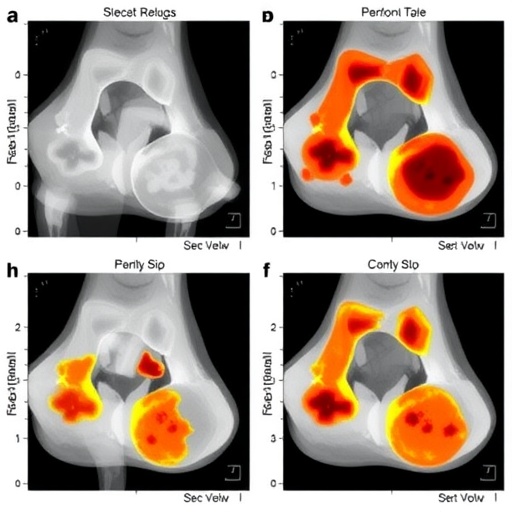
The relentless battle against wild poliovirus has entered a critical new phase, as a groundbreaking study published in Nature Communications reveals intricate details about the virus’s evolution and transmission dynamics in two of the last endemic strongholds: Pakistan and Afghanistan. Spanning an unprecedented 11-year period from 2012 to 2023, this comprehensive research exposes how the virus has adapted, persisted, and spread despite intensive global eradication efforts. It offers an invaluable window into the molecular underpinnings and epidemiological patterns that continue to challenge public health authorities in the region.
At the heart of this investigation lies an extensive genomic sequencing effort, which has generated a detailed map of the genetic changes accumulated by wild poliovirus strains circulating across Pakistan and Afghanistan. Through high-resolution phylogenetic analysis, researchers have traced the virus’s evolutionary trajectory, revealing a complex mosaic of lineages that reflect both localized chains of transmission and occasional cross-border movement. The granularity of this data provides unprecedented clarity on how distinct viral populations emerge, compete, and sometimes vanish, contributing to both flare-ups and silent persistence.
Understanding the evolutionary tempo of poliovirus is crucial because its mutation rate directly influences vaccine efficacy and the potential for vaccine-derived poliovirus to arise. This study quantifies the substitution rates and identifies hotspots within the viral genome where mutations confer selective advantages or influence antigenic properties. These genetic insights help elucidate the mechanisms by which the virus evades immune pressure, facilitating the design of next-generation vaccines better tailored to the circulating strains—a vital step as the world edges closer to global eradication.
.adsslot_bM8YBtROcu{width:728px !important;height:90px !important;}
@media(max-width:1199px){ .adsslot_bM8YBtROcu{width:468px !important;height:60px !important;}
}
@media(max-width:767px){ .adsslot_bM8YBtROcu{width:320px !important;height:50px !important;}
}
ADVERTISEMENT
Beyond genetic evolution, the research delves deeply into transmission dynamics. Using sophisticated statistical models that integrate genomic data with epidemiological inputs—such as reported cases, vaccination campaigns, and population movement patterns—the study reconstructs transmission chains with remarkable precision. These models illuminate not only the geographic pathways the virus follows but also temporal fluctuations in transmission intensity, highlighting seasons of heightened risk and the impact of interventions.
One of the study’s most striking findings is the identification of persistent viral reservoirs, especially in conflict-affected and hard-to-reach areas in both countries. These reservoirs sustain long-term circulation even when apparent case numbers decline sharply elsewhere, underscoring the virus’s cunning survival strategy. The research underscores that achieving complete interruption of transmission requires targeted strategies that address these resilient pockets with innovative surveillance and vaccination approaches.
This work also uncovers the role of human mobility patterns in shaping poliovirus spread. Analysis of population census data, refugee movements, and informal transit routes reveals how the virus capitalizes on sociopolitical disruptions and population displacements. Such insights provide actionable intelligence to health authorities designing campaigns that anticipate and counteract these transmission corridors, emphasizing cross-border collaboration.
Emerging from the data is a sobering realization: despite strides made through intensified immunization drives and enhanced surveillance, eradication remains elusive. The persistence of wild poliovirus in Pakistan and Afghanistan highlights the multifaceted challenges posed by sociopolitical instability, logistical constraints, vaccine hesitancy, and the virus’s own evolutionary adaptability. These intertwined factors create a dynamic battleground where public health responses must continuously adapt to shifting viral and human landscapes.
The study pays special attention to vaccine-derived polioviruses and their role in the epidemiological landscape. By comparing genetic signatures of wild and vaccine-derived strains, researchers delineate the precursors and evolutionary steps leading to vaccine-derived outbreaks, helping to pinpoint risk factors and inform the judicious use of oral polio vaccines in these fragile settings. This knowledge is crucial for mitigating one of the paradoxical threats complicating eradication efforts.
Importantly, the analytic techniques employed push the frontier of molecular epidemiology. The integration of deep sequencing, real-time phylogenetics, and transmission modeling sets a new standard for poliovirus surveillance and response. This synergy not only enhances outbreak detection and characterization but also provides predictive capabilities—enabling proactive rather than reactive measures. Such methodological advances hold promise for broader applications in infectious disease control globally.
Policy implications stemming from this work are profound. It advocates for a recalibrated approach that foregrounds molecular surveillance as an indispensable tool for eradication programs, combined with enhanced community engagement and innovative vaccination strategies adapted to local contexts. The data-driven recommendations emphasize agility and precision, counterbalancing the traditional reliance on case counts and broad immunization strategies.
This study also raises critical questions about the feasibility of complete eradication in conflict zones where access to children is intermittently cut off and health infrastructure is fragile. It highlights the necessity of integrating health initiatives with peace-building and socio-economic stabilizing efforts—recognizing that public health outcomes are inseparable from the broader fabric of societal resilience.
By elucidating the complex interplay between viral evolution, human behavior, and intervention strategies, the research underscores the relentless arms race between pathogen and public health. It is a clarion call for sustained vigilance, investment, and innovation to rid the world of poliovirus once and for all, while offering a roadmap grounded in molecular science and epidemiological rigor.
The implications of these findings extend beyond polio alone. The approaches and insights derived have broad relevance for managing other viral infections in similarly challenging settings. As global health increasingly faces the twin threats of emerging pathogens and endemic diseases in fragile environments, this study exemplifies how cutting-edge science can inform targeted, context-specific interventions.
In sum, the decade-long deep dive into the wild poliovirus genetic landscape and transmission in Pakistan and Afghanistan represents a landmark achievement. It enriches our understanding of viral persistence under pressure and equips public health stakeholders with the knowledge to refine tactics against one of the world’s oldest and most feared pathogens. The quest for a polio-free planet is not merely a scientific challenge but a testament to human will and ingenuity, vividly captured in this exemplary research.
Subject of Research: Evolution and transmission dynamics of wild poliovirus in Pakistan and Afghanistan from 2012 to 2023
Article Title: Evolution and transmission dynamics of wild poliovirus in Pakistan and Afghanistan (2012-2023)
Article References:
Jorgensen, D., Pons-Salort, M., Salman, M. et al. Evolution and transmission dynamics of wild poliovirus in Pakistan and Afghanistan (2012-2023). Nat Commun 16, 5170 (2025). https://doi.org/10.1038/s41467-025-60432-x
Image Credits: AI Generated
Tags: cross-border virus transmissionendemic poliovirus regionsepidemiological patterns of poliovirusgenomic sequencing of poliovirusmolecular underpinnings of poliovirusPakistan and Afghanistan public healthphylogenetic analysis of virusespoliovirus eradication effortspoliovirus transmission dynamicstracking poliovirus lineages and flare-upsvaccine efficacy and mutationswild poliovirus evolution





